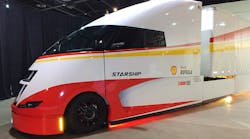JACKSONVILLE, FL. The Shell Starship ended its 2,300-mile trip from San Diego, CA, to Jacksonville, FL, on Tuesday with a presentation highlighting the tractor-trailer’s efforts to improve fuel efficiency and reduce emissions.
But, as Shell’s Chris Guerrero pointed out, the real journey is only beginning.
The goal with the ship’s maiden voyage was to explore the Class 8 truck’s potential to increase freight-ton efficiency by transporting a 39,000-lb. payload of artificial reef material from California to Florida.
The long-term goal is to drive the fuel-economy conversation into the future.
“There’s more work left to be done,” said Guerrero, the global marketing director for Shell Lubricants.
“Four years ago, when we talked about the possibility of working with Bob Sliwa and AirFlow Truck Company, we recognized there was an opportunity for us to do more than test low-viscosity fluids in fuel-economy applications. That’s something we do regularly. We thought there was an opportunity to raise the level of discourse and dialogue around fuel economy, and what’s possible.
“Through perseverance and hard work – something every truck driver is well-acquainted with – we arrived here today, not in Jacksonville, but at a crossroads of where we move going forward.”
The trip
Sliwa, who partnered with Shell to design and build the “hyper-aerodynamic, super fuel-efficient” truck, also piloted the Starship across the country, battling real-world conditions truckers see daily, like traffic, bad weather and even a tire blowout, along with unique challenges.
The truck was bombarded by curious passersby throughout its journey, both on the highway and during stops along the way, including a state trooper who pulled the truck over as it entered Florida.
“We weren’t doing anything wrong, he was just so enthralled and intrigued by the truck,” Sliwa said.
“He told me during our stop autonomous vehicles are allowed in Florida now, and he didn’t know if it was autonomous, and I guess he wanted to see if the robot would stop when he lit him up.”
Sliwa said the trooper, who does training for the Commercial Vehicle Safety Alliance, eventually let them go, after taking plenty of pictures – to document the vehicle and, most likely, for himself.
He wasn’t the only one, either.
“All day long cars were coming by with cell phones, taking video (and) pictures,” Sliwa said. “The truckers were some of the worst. Going through California, a trucker was going 49 mph in the fast lane with his four-way flashers because he wanted us to pass him on the right so he could make a movie.
“The guy wanted to see the truck, but that raised my stress level through the roof.”
The technology
The truck took three years and 18,000 man-hours to conceive and construct, all with Shell Rotella financing, and Sliwa’s company not only built it, but he was charged with delivering it to Jacksonville intact.
Mission accomplished.
Even the extremely low-profile trailer skirts – only 3-4 inches off the ground – made the trek undamaged.
“This is a very expensive truck,” Sliwa quipped. “Shell paid a lot of money for me to build it – although way less than the SuperTruck folks.”
The “co-engineered” Starship features a custom-made cab crafted entirely of carbon fiber; active grill shutters that open for cooling, when necessary, and close to improve aerodynamics when not; boat tail, trailers skirts and automatic tractor fairings for streamlining; automated tire inflation system; and a 5,000-watt solar array covering the trailer roof that powers the cab’s air conditioner.
Shell intended to use Hyliion’s hybrid electric axle system, which provides a power boost uphill and captures braking energy downhill to recharge the tractor’s battery pack, but the project ran out of time.
“The technology’s not on the tractor yet,” Hyliion CEO Thomas Healy said. “It was one of those things where, as we were coming to the completion of this, timing-wise it didn’t work out. But in the next couple of months here, we’ll replace the rear axle of the tractor with a fully electric axle, and then mount our battery-box control systems on it, and make into a hybrid truck.”
The results
The Starship truck’s first-of-its-kind testing concluded May 24 and was third-party verified by the North American Council for Freight Efficiency (NACFE). The truck achieved an average fuel economy of 8.94 miles per gallon compared to the average U.S. fuel economy for transport trucks of 6.4 miles per gallon.
They averaged 10.2 mpg during one 100-mile stretch in Texas.
Those results were with a gross vehicle weight of nearly 73,000 lbs., which is 28% heavier than average, according to joint statistics compiled by the EPA and National Highway Traffic Safety Administration.
But the most important number, said Bob Mainwaring, Shell Lubricants’ technology manager for innovation, is 178.4, which is the ton-miles per gallon for freight-ton efficiency, a more relevant measurement of energy intensity that combines a cargo’s weight with the amount of fuel consumed.
The North American average for trucks is 72 ton-miles per gallon, according to a NACFE report.
“Our goal with the Starship Initiative is to challenge how the trucking industry is defined,” Mainwaring said. “Through this road trip, we were able to test the Starship truck along with a number of technologies available today to provide insight into what trucking fleets and owner/operators could consider adopting to help reduce fuel use and emissions as they haul heavy loads.
“This includes optimized aerodynamics, drivetrain and operational efficiencies, and low viscosity lubricants.”
With Starship technology on all the 2 million trucks in the U.S., Shell extrapolates an estimated 229 million less tons of CO2 entering the atmosphere per year – a 60% reduction in emissions.
“These and other learnings are not the final results,” Mainwaring said. “They are simply the start of our ongoing learning.”




